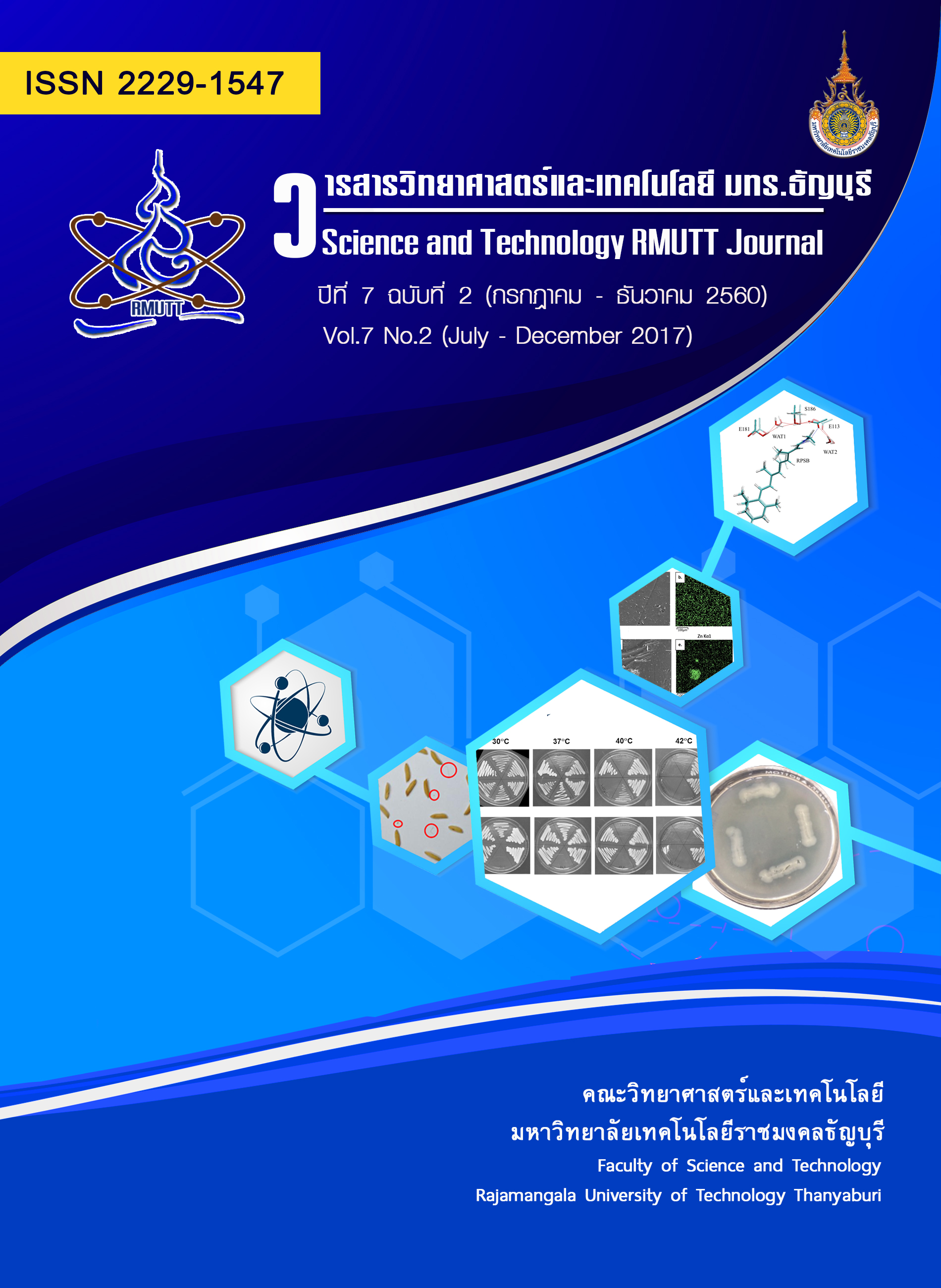Isolation and Lipid Decomposition Efficiency of Bacteria Isolated from Canteen Wastewater
Main Article Content
Abstract
The aims of this research were to isolate the lipid degrading bacteria from canteen wastewater and to study the lipid hydrolysis efficiency of selected bacteria in the synthetic lipid wastewater. Twenty purified bacterial isolates obtained by randomly colonial selection were primarily tested for lipase enzyme production by using Tributyrin agar medium. As a result, nine of twenty isolates (9/20 isolates, 45%) which were isolates WA4, WA5, WA8, WA9, WA11, WA13, WA14, WA18 and WA19 could generate the clear zone; while the isolate WA5 gave the highest clear zone of 7.5 millimeters, indicating all nine isolates were lipolytic bacteria. Four of nine isolates (4/9, 44.44%) were gram positive with rod-shape, two of nine (2/9, 22.22%) isolate were gram positive with cocci-shape and three of nine (3/9, 33.33%) isolates were gram negative with rod-shape bacteria. The isolate WA5 was selected for testing the lipid hydrolysis efficiency. The result found that it could decompose the synthetic lipid wastewater containing plant lipid and animal lipid by decreasing the lipid concentration in average of 20.44% and 52.84%, respectively. While, the Bacillus subtilis laboratory strain could reduce the lipid concentration in average of 7.20% and 10.72%, respectively. It was indicated that the isolate WA5 which was isolated from lipid contaminated environment had higher hydrolysis efficiency than B. subtilis by 3-5 times.
Article Details
References
George N., Mustafa A.S., Amerjeet B. and Victor L. Anaerobic treatability of high oil and grease rendering. Wastewater Hazardous Materials. 2003. B(102): 243-255.
กรมควบคุมมลพิษ. คู่มือแนวทางการจัดการน้ำมันและไขมันจากบ่อดักไขมันและการนำ ไปใช้ประโยชน์สำหรับชุมชน. 2551. (ออนไลน์). เข้าถึงได้จาก :
http://infofile.pcd.go.th/water/manual_Commu09.pdf?CFID=1986315&CFTOKEN=51831307.
Wakelin N.G. and Forster C.F. An investigation into microbial removal of fats, oils and greases. Bioresource Technology. 1997. 59: 37-43.
Matsumiya Y., Wakita D., Kimura A., Sanpa S. and Kubo M. Isolation and characterization of a lipid-degrading bacterium and its application to lipid-containing wastewater treatment. Journal of Bioscience and Bioengineering. 2007. 103:325-330.
Prasad M.P. and Manjunath K. Comparative study on biodegradation of lipid-rich wastewater using lipase producing bacteria species. Indian Journal of Biotechnology. 2011. 10: 121-124.
กิจจา จิตรภิรมย์ และ ปธานิน แสงอรุณ. การตรวจหาแบคทีเรียย่อยไขมันจากตัวอย่างสิ่งแวดล้อม. วารสารสาธารณสุขศาสตร์. 2555. 42(3): 3-18.
อลงกฏ แซมสีม่วง ศิริพรรณ สารินทร์ และจรูญ สารินทร์. การศึกษาการใช้แบคทีเรียที่สร้างสารลดแรงตึงผิวชีวภาพและเอนไซม์ไลเปสในการย่อยสลายไขมันและน้ำมัน. Journal of Community Development Research. 2011. 4(2): 18-25.
Verma S. and Shama K.P. Isolation, identification and characterization of lipase producing microorganisms from environment. Asian Journal of Pharmaceutical and Clinical Research. 2014. 7: 219-222.
Veerapagu M., Sankara N.A., Jeya K.R. and Alagendran S. Isolation and identification of a novel lipase producing bacteria from oil spilled soil. International Journal of Innovative Research in Science, Engineering and Technology. 2007. 3: 18122-18129.
ประชุมพร เลาห์ประเสริฐ เจนจิรา แพงจันทร์ เจษฎา ชาญศิริรัตนา ตันติกร ขุนาพรม. การบำบัดไขมันในบ่อดักไขมันโรงอาหารโดยใช้กลุ่มแบคทีเรียคัดสายพันธุ์. วารสารมหาวิทยาลัยศรีนครินทรวิโรฒ (สาขาวิทยาศาสตร์และเทคโนโลยี). 2558. 13: 41-49.
Phong N.T., Duyen N.T. and Diep C.N. Isolation and characterization of lipid-degrading bacteria in wastewater of food processing plants and restaurants in Can Tho city, Vietnam. American Journal of Life Sciences. 2014. 2: 382-388.
Vishwe V.S., Gajbhiye S.P., Vaidya S.P. and Chowdhary A.S. Isolation and characterization of lipolytic Pseudomonas spp. from oil contaminated water samples. IOSR Journal of Biotechnology and Biochemistry. 2015. 1: 33-36.
Sugimori D., Nakamura M. and Mihara Y. Microbial degradation of lipid by Acinetobacter sp. Strain SOD-1. Bioscience, Biotechnology, and Biochemistry. 2002. 66: 1579-1582.
อรอุษา รุ่งเรือง และ ปราณี พัฒนพิพิธไพศาล. การบำบัดน้ำเสียปนเปื้อนไขมันด้วยเซลล์แบคทีเรียตรึงรูปและไลเปสตรึงรูปต่าง ๆ. 2554. (ออนไลน์). เข้าถึงได้จาก : http://www.conference.phuket.psu.ac.th/proceedings/PSU_OPEN_WEEK_2011/data/SCI/Sci011_paper.pdf.
จิราวรรณ มลาไวย์ สายน้ำผึ้ง ฉายาพัฒน์ และ ปราณี พัฒนพิพิธไพศาล. การคัดเลือกไลเปสจากแบคทีเรียชอบอุณภูมิสูงเพื่อการบำบัดน้ำเสียที่ปนเปื้อนไขมัน. วารสารวิทยาศาสตร์และเทคโนโลยี. 2555. 14(2): 71-77.
Chappe, P., Mourey, A. and Kibertus, G. Variation of lipolitc activity in the genus Acinetobacter sp. Journal of General & Applied Microbiology. 1994. 4: 103-114.
American Public Health Association, American Water Works Asssociation, Water Environment Federation. Standard methods for the examination of water and wastewater” 20th Edition, Washington. D.C: APHA-AWWA-WEF. 1998.
มั่นสิน ตัณฑุลเวศม์. คู่มือวิเคราะห์คุณภาพน้ำ. พิมพ์ครั้งที่ 2. กรุงเทพ : จุฬาลงกรณ์มหาวิทยาลัย. 2540.
ลิพิดและกรดไขมัน. (ออนไลน์). เข้าถึงได้จาก :https://ag2.kku.ac.th/eLearning/137748/Doc%5CChapter%204%20Lipid%20and%20fatty%20acid.pdf.
บทนำเรื่องไลเปส. (ออนไลน์). เข้าถึงได้จาก : http://kb.psu.ac.th/psukb/bitstream/2553/ 2391/12/223354_ch1.pdf.
Rocha D.C.D., Gomes B.M., Gomes S.D., Sene L. and Zenatti C. Selection of microorganisms producer of lipase for fat removal from biodiesel purification water. Engenharia Agrícola. 2013. 33: 332-340.


